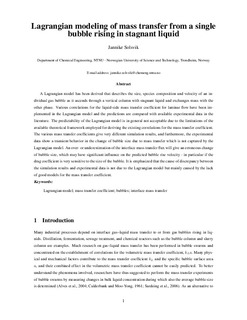| dc.contributor.author | Solsvik, Jannike | |
| dc.date.accessioned | 2019-06-17T09:05:44Z | |
| dc.date.available | 2019-06-17T09:05:44Z | |
| dc.date.created | 2018-12-05T14:46:06Z | |
| dc.date.issued | 2018 | |
| dc.identifier.citation | Chemical Engineering Science. 2018, 190 370-383. | nb_NO |
| dc.identifier.issn | 0009-2509 | |
| dc.identifier.uri | http://hdl.handle.net/11250/2600958 | |
| dc.description.abstract | A Lagrangian model has been derived that describes the size, species composition and velocity of an individual gas bubble as it ascends through a vertical column with stagnant liquid and exchanges mass with the other phase. Various correlations for the liquid-side mass transfer coefficient for laminar flow have been implemented in the Lagrangian model and the predictions are compared with available experimental data in the literature. The predictability of the Lagrangian model is in general not acceptable due to the limitations of the available theoretical framework employed for deriving the existing correlations for the mass transfer coefficient. The various mass transfer coefficients give very different simulation results, and furthermore, the experimental data show a transient behavior in the change of bubble size due to mass transfer which is not captured by the Lagrangian model. An over- or underestimation of the interface mass transfer flux will give an erroneous change of bubble size, which may have significant influence on the predicted bubble rise velocity - in particular if the drag coefficient is very sensitive to the size of the bubble. It is emphasized that the cause of discrepancy between the simulation results and experimental data is not due to the Lagrangian model but mainly caused by the lack of good models for the mass transfer coefficient. | nb_NO |
| dc.language.iso | eng | nb_NO |
| dc.publisher | Elsevier | nb_NO |
| dc.rights | Attribution-NonCommercial-NoDerivatives 4.0 Internasjonal | * |
| dc.rights.uri | http://creativecommons.org/licenses/by-nc-nd/4.0/deed.no | * |
| dc.title | Lagrangian modeling of mass transfer from a single bubble rising in stagnant liquid | nb_NO |
| dc.type | Journal article | nb_NO |
| dc.type | Peer reviewed | nb_NO |
| dc.description.version | acceptedVersion | nb_NO |
| dc.source.pagenumber | 370-383 | nb_NO |
| dc.source.volume | 190 | nb_NO |
| dc.source.journal | Chemical Engineering Science | nb_NO |
| dc.identifier.doi | 10.1016/j.ces.2018.06.002 | |
| dc.identifier.cristin | 1639525 | |
| dc.description.localcode | © 2018. This is the authors’ accepted and refereed manuscript to the article. Locked until 4 June 2020 due to copyright restrictions. This manuscript version is made available under the CC-BY-NC-ND 4.0 license http://creativecommons.org/licenses/by-nc-nd/4.0/ | nb_NO |
| cristin.unitcode | 194,66,30,0 | |
| cristin.unitname | Institutt for kjemisk prosessteknologi | |
| cristin.ispublished | true | |
| cristin.fulltext | preprint | |
| cristin.qualitycode | 2 | |

